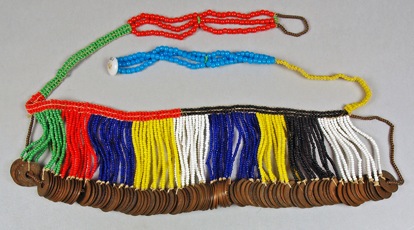Marriage belt
Kenya, Made circa 1950s
 Collected by E. June Knowles 1957–1981, and donated by her in 1996; 1996.52.1Beadwork is one of Africa's best-known artistic traditions. For several hundred years most glass beads have been imported from Europe. Indigenous glass making in Africa often involves the use of recycled glass from bottles and other items. The colours and patterns of beaded decoration are sometimes, if seldom, random and usually declare not only an ethnic affiliation but can also indicate clan and age-group connections as well.
Collected by E. June Knowles 1957–1981, and donated by her in 1996; 1996.52.1Beadwork is one of Africa's best-known artistic traditions. For several hundred years most glass beads have been imported from Europe. Indigenous glass making in Africa often involves the use of recycled glass from bottles and other items. The colours and patterns of beaded decoration are sometimes, if seldom, random and usually declare not only an ethnic affiliation but can also indicate clan and age-group connections as well.
This belt or apron dates to the 1950s. Said to have been worn by at a marriage ceremony, it is made of multi-coloured blocks of beads, attached to 102 one-cent East African copper coins dating from 1922 to 1957. These are suspended on a copper chain running through a central drilled hole. It is uncertain which cultural group made it. Up until the mid-20th century the wearing of beaded goatskins was widespread in rural Kenya. The Kamba people living in the semi-arid Eastern Province of Kenya for instance often made use of chains and coins not only as visual decoration but also to give a pleasant sound effect as the wearer moved and walked. However, most Kamba beadwork features intricate designs and motifs such as arrowheads, rectangles, diamonds, and crosses and emphasises the use of white beads, rather than blocks of bright colours.
The Masai also use beaded ornaments to symbolise status. Unmarried women wear beaded collars of varying circumferences; in contrast married women usually wear a large collar that entirely fills the space between the chin and the shoulders, made of woven dark grass with a series of single oblong red beads running down the centre. Married women may also wear large, looped leather and bead earrings. Among the Kamba and Masai, both pastoralist societies, marriage practices included the exchange of cattle as a form of bridewealth payment.
